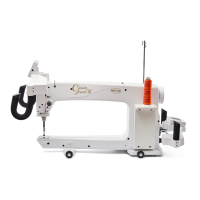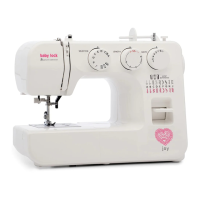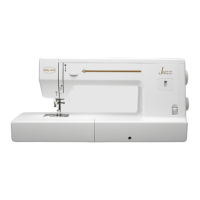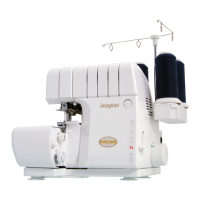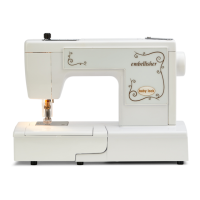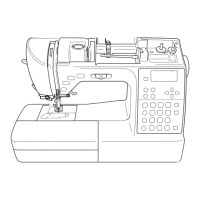Do you have a question about the Baby Lock Jubilant BL80B and is the answer not in the manual?
Precautions to reduce the risk of electrical shock.
Precautions to reduce risks of burns, fire, electric shock, or injury.
Precautions regarding AC power source, converters, and qualified electricians.
Safety guidelines for operating damaged machines and during transport.
Keep work area clear, avoid blocking air openings, and do not store objects on foot controller.
Pay attention to needle, keep fingers away from moving parts, use correct needle plate.
Keep the manual for future reference.
Safety guidelines tailored for users in different geographical regions.
Specific safety notes for users in the UK, Eire, Malta, and Cyprus.
Locates and names the primary components of the sewing machine.
Lists and describes the accessories that come with the sewing machine.
Details accessories available for separate purchase.
Step-by-step guide to attach the stitch pattern plate to the machine.
Instructions for safely turning the sewing machine on and off.
Explains the information and symbols shown on the LCD screen.
Guides users on how to change settings like buzzer and needle stop position.
Detailed steps for winding thread onto a bobbin and installing it correctly.
Comprehensive instructions for correctly threading the upper thread on the machine.
Guidance on selecting appropriate fabric, thread, and needle combinations for best results.
Step-by-step instructions for safely checking and replacing the sewing machine needle.
Procedure for safely removing and attaching different presser feet.
Covers the fundamental steps and safety precautions for operating the sewing machine.
Provides tips for improving sewing results and techniques.
Recommends trial sewing for checking results and adjusting tension/length.
Techniques for turning fabric at corners to change sewing direction.
Guides on setting stitch width and aligning fabric for consistent seam allowances.
Methods for sewing curves by adjusting fabric and needle position.
Advice for sewing thick, thin, stretch, leather, and vinyl fabrics.
Tips for sewing thin fabrics, including using stabilizer.
Guidance for sewing stretch fabrics, including needle and stitch recommendations.
Using special presser feet or copy paper for sewing leather or vinyl.
Instructions for sewing hook-and-loop fastener tape, including precautions.
Guidance on using decorative stitches, including fabric and thread recommendations.
A detailed chart listing available stitches, their uses, and settings.
Details on common utility stitches like overcasting, blind hemming, and buttonholes.
Step-by-step instructions for creating a blind hem on garments.
Instructions for creating buttonholes, including adjustments for fabric type.
Tips for sewing buttonholes on stretch fabrics with gimp thread.
Instructions on how to sew buttons onto fabric using the machine.
Step-by-step guide for inserting a centered zipper into fabric.
Methods for appliqué, patchwork, and quilting using specific stitches.
Using walking foot and quilting guide for basic quilting.
Guidance on performing free motion quilting with appropriate settings.
How to attach elastic tape to fabric for waistbands or cuffs.
Procedure for sewing bar tacks to reinforce stress points like pocket corners.
Stitching across an open seam for decorative effects, especially with thicker thread.
Using decorative stitches to create smocking for texture and elasticity.
Using a wave-shaped stitch pattern to decorate edges and collars.
Creating shell tucks for decorating trims and fabric edges.
Using decorative stitches to join fabrics, often for crazy quilts.
Guide to installing and using a twin needle for parallel stitching.
How to adjust stitch patterns for better results based on fabric and settings.
Instructions for cleaning, oiling restrictions, and storing the machine properly.
Information that the machine does not require user oiling and when to contact service.
Guidelines on avoiding locations that could damage the machine during storage.
Procedure for cleaning lint and dust from the bobbin race for optimal performance.
A comprehensive guide to diagnosing and resolving common sewing machine issues.
Diagnoses and remedies for problems with the upper thread tension being too tight.
Troubleshooting steps for fabric tangling and rattling noises.
Identifies symptoms and causes of incorrect thread tension issues.
Procedure for safely removing fabric caught in the sewing machine.
Troubleshooting for thread becoming tangled under the bobbin winder seat.
A reference list of common symptoms and their corresponding solutions or causes.
Solutions for issues like the machine not starting or buttons not responding.
Addresses causes and solutions for needle breaking, bending, or incorrect installation.
Troubleshooting steps for issues causing the bobbin thread to break.
Solutions for fabric puckering and related issues.
Troubleshooting for problems with fabric not feeding correctly through the machine.
Troubleshooting for unusual sounds and incorrect fabric feeding direction.
Solutions for issues related to the needle plate and presser foot condition.
Explains common error messages and provides solutions for each.
Explains the meaning of machine beeps indicating correct or incorrect operations.
Procedure for safely removing a needle that has fallen inside the machine.
Addresses issues with the handwheel not turning smoothly and incorrect thread tension.
| Number of Stitches | 80 |
|---|---|
| Buttonhole Styles | 7 |
| Needle Threading System | Automatic |
| Sewing Speed | 850 stitches per minute |
| LCD Screen | Yes |
| USB Port | No |
| Bobbin System | Top drop-in bobbin |
